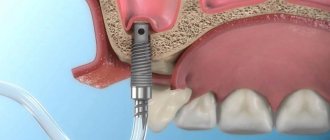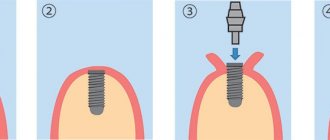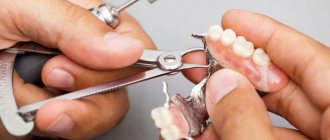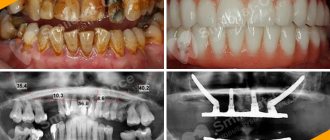The elevated sugar levels that accompany diabetes impair wound healing. And this is the main obstacle due to which implantation has not been available to diabetics for many years.
The classical technique, which was used everywhere, involved an incision in the gum and partial destruction of the bone to create an implantation bed. At the end of the procedure, the implanted implant was covered with a gum flap and sutures were applied.
In good health, engraftment occurred within 6-8 months. In diabetes, this period was extended, the wounds did not heal for a long time, and it was not always possible to achieve reliable stabilization of the implant. It is because of these risks that the disease has been a contraindication for implantation for decades.
What are the risk factors for implantation in diabetic patients?
Diabetes mellitus is caused by disruption of the endocrine system. Against this background, the body produces less insulin than is needed to break down the sugars coming from food. This negatively affects metabolic processes, leads to disruption of blood microcirculation, which impairs tissue regeneration.
Any wound in diabetics recovers more difficult and takes longer. Upon implantation:
- allergic reactions are possible;
- complications and implant rejection;
- the engraftment period increases.
Despite this, diabetes is not a death sentence for implantation. Today, implantation protocols have been developed and successfully applied to treat this category of patients. It is possible to restore individual teeth or the entire jaw using the “All on 4” technique.
Possible risks
In patients with diabetes, metabolic processes are disrupted, hormonal levels are unstable, injured tissues regenerate slowly, and blood supply to blood vessels is difficult. These factors explain the increased risk of complications after implantation. Possible consequences include:
- allergic reaction;
- complicated engraftment;
- implant rejection.
The risk of complications increases as the diabetic’s experience increases—the longer the patient is sick, the higher the risk of implant therapy.
Who is not recommended for diabetes implantation?
The procedure is not suitable if you have problems with the immune system. Against the background of diabetes, the immune response is significantly reduced, and engraftment will take longer and be more likely to cause complications.
It is necessary to take a balanced approach to prescribing implantation for people with type 2 diabetes who are receiving treatment with injectable insulin for severe diabetes.
In any case, the presence of specific contraindications can only be identified by a dentist in close cooperation with an endocrinologist. Come for a consultation at our clinic to get more information.
Who is eligible for implantation for diabetes?
Modern implant prosthetics are available for people with diabetes in a number of cases:
- Their general health should be good.
- There should be no contraindications to the procedure or chronic diseases of other body systems (cardiovascular, circulatory).
- The blood glucose level during treatment should be normal (up to 7 mmol/l).
- You need to obtain permission from a therapist and endocrinologist to perform implantation.
- Tissue regeneration should not be impaired. Small wounds of the patient’s mucous membrane and skin heal in normal time.
- There should be no addiction to nicotine. Smoking leads to a narrowing of blood vessels already damaged by diabetes, and the blood supply to the bone will not be sufficient for its regeneration.
Considering the risks, people with diabetes need to contact specialists who have successful experience working with this category of patients. According to the dental association, this is one of the main conditions for successful implantation in diabetics.
When is surgery possible?
- Diabetes mellitus type 2 (without hormonal regulation of diabetes);
- compensated form (glucose level is stable - at 7-9 mol/l before surgery and during the engraftment period);
- the patient carries out maintenance therapy, takes hypoglycemic medications, and follows a low-carbohydrate diet;
- the process of tissue regeneration in the body is not disrupted (abrasions and bruises do not lead to complications);
- giving up bad habits (cigarettes, drinking alcohol);
- absence of concomitant pathologies (diseases of the thyroid gland, cardiovascular and circulatory systems);
- the possibility of organizing regular monitoring by an endocrinologist and attending physician.
What are the requirements for implantation for diabetes?
In order for the implants to take root in a timely manner and achieve good stabilization, it is necessary to create a number of conditions:
- Make sure that the glucose level on the treatment you receive remains at a normal level for a long time and stably (up to 7 mmol/l).
- Provide diabetes compensation for the entire period of treatment (maintenance therapy).
- Follow a diet and physical activity (avoid exercise, eat frequently, in small portions, adhere to a diet rich in vitamins and low in carbohydrates).
- Avoid stress, which negatively affects the nervous system and is detrimental to diabetics.
- Throughout the recovery period after implantation, it is necessary to be regularly monitored by an implantologist and endocrinologist.
- It is necessary to take very good care of your oral cavity every day - carry out hygiene measures recommended by your dentist.
Rules for oral care during the rehabilitation period
If a patient with diabetes mellitus follows simple rules for oral care after implantation, then the risk of complications now and in the future is virtually eliminated. Proper care includes the following:
- immediately after surgery and during the first 3-5 days, only oral baths are allowed; you cannot use a brush due to the risk of damage to sutures and injured tissues: after each meal, you need to put a little clean warm water or an antiseptic solution prescribed by your dentist into your mouth, and hold the liquid for about a minute,
- regular use of brushes and pastes, starting from 3-5 days after implantation: you will have to carefully brush not only the remaining teeth, but also the denture. There are special pastes for this. You can alternate pastes labeled “for dentures” and “for diabetes.” It is better to buy a new brush, of medium hardness and with a large number of bristles. This tool will have to be changed every 2-3 months, because... plaque and microbes accumulate in the pile,
- use of an irrigator after 2 weeks and thereafter: this device, using a narrowly directed stream of water, perfectly rinses the interdental and subprosthetic space, and also removes plaque from teeth and dentures.
It is important to take all medications prescribed by the implantologist during the rehabilitation period. Moreover, it is better to take this list BEFORE the operation and agree with the endocrinologist. Of course, you need to control your glucose levels, eat properly and nutritiously, and take medications for the underlying disease. Every 6-12 months you should visit the dental clinic for a professional examination and cleaning of dentures.
[1] Grossi SG, Zambon JJ Assessment of risk for periodontal disease. Risk indicators for attachment loss // J Periodontol, 1994.
[2] Matyuta M.A. [and others] Dental implantation for type II diabetes mellitus / International Student Scientific Bulletin. – 2016.
Author: Namdakov N.V. (Thank you for your help in writing the article and the information provided)
What implants and prostheses can be placed for diabetes?
The body of a person with diabetes reacts more sharply to external influences, therefore both implants and prostheses for diabetics must be bioinert. Titanium implants without impurities and zirconium metal-free crowns have proven themselves well. When choosing dentures, preference is given to lightweight materials and their design is carefully thought out in order to achieve uniform distribution of the load when chewing.
The type of implants, prostheses and their location are planned at the stage of preparation for implantation. Based on the CT results, a three-dimensional model of the patient’s jaw is created. Next, with the help of special programs, they mark on it which implants will be implanted and how.
After approval of the operation plan, a special 3D template is created using this data. During the procedure, it is placed on the jaw and the implant is inserted at precisely marked points on it.
What types of implantation can be used for diabetes?
To reduce the burden on the body, it is very important to use gentle types of implantation:
- Simultaneous implantation with immediate loading.
In this procedure, an implant is placed into the socket of a newly extracted tooth. In this case, there is no need to further injure the tissue, and healing proceeds physiologically, just as a hole would gradually heal at the site of the removed root. Temporary prostheses with immediate loading are installed immediately, permanent ones - after complete engraftment. - Express implantation with immediate loading.
This procedure is chosen to place an implant in an empty space in the jaw where a tooth previously was. If the removal was carried out recently, the hole should be completely restored. A puncture is made with a thin instrument (only 1-2 mm in diameter). An implant with a special thread is screwed inside. It does not contribute to bone destruction and immediately guarantees good primary stabilization. Temporary load-bearing dentures with this method can also be put on immediately.
In some cases, the classic protocol
. Today, thanks to new generation implants, this is a more gentle procedure. Fusion of the titanium rod with the bone occurs in an unloaded state (the implant is covered with a gum flap, and osseointegration occurs inside the gum). After complete engraftment, prosthetics are performed.
Preparatory period and installation of implants
The protocol for implanting an artificial tooth root in diabetics is no different from implantation in healthy patients. The operation can be performed either using the classical method with delayed loading (the crown is fixed after complete engraftment) or with immediate loading (the prosthesis is installed immediately or 3-5 days after the operation). The specialist chooses the specific method after carefully studying the patient’s health condition.
Before implantation, the following preparatory measures must be taken:
- Take all necessary blood, urine, and saliva tests . It is also necessary to determine your blood sugar level and consult an endocrinologist or therapist.
- Carry out thorough sanitation of the oral cavity . It is necessary to remove all carious lesions, remove tartar and plaque, and also be more careful about brushing your teeth a month or several weeks before surgery.
- Diagnose the condition of the jaw to identify hidden pathologies, determine the quality and quantity of the bone structure.
The implantation procedure should be carried out as carefully as possible and with minimal tissue damage to ensure rapid healing and avoid the development of complications. In this case, the best option is a minimally invasive implantation method.
What tests and examinations will a diabetic need before implantation?
Diagnostics for diabetes is much more extensive than in the usual case. In addition to the mandatory general blood test, CT or MRI, a person with diabetes must undergo:
- blood for sugar;
- urine for general analysis;
- saliva for bacterial culture.
Based on the results of these examinations and your general health, you will need to consult a therapist and an endocrinologist, and obtain confirmation from both doctors that there are no obstacles to implantation due to health reasons.
More attention is also being paid to CT scanning for diabetes. It is necessary to make sure that the patient’s existing disease does not have hidden problems with bone tissue. During the examination, bone density, volume and quality are assessed.
What preparation does a diabetic have to undergo before implantation?
In our clinic “AcademStom” we carry out thorough sanitation of the oral cavity:
- Professional hygienic cleaning with removal of soft and hard dental deposits (tartar).
It is known that plaque is a breeding ground for bacteria; removing it can prevent tissue infection and implant rejection. - Fighting caries.
A carious tooth is a source of infection in the body. - Gum treatment.
Before implantation, you need to make sure that the patient does not have gingivitis or other soft tissue diseases. - Bleaching.
If there are no contraindications and there is a need, before the implantation procedure it is necessary to restore the natural color of the tooth enamel.
Patients who have completed all the necessary preparation are allowed to undergo implantation.
The influence of the disease on the condition of the teeth
With an increase in blood sugar levels, the negative effect of glucose on the body increases - conditions appear for the development of a number of oral diseases:
- Hyposalivation (saliva deficiency). Dry mouth destroys the enamel layer - caries develops, and pathogenic microflora spreads in the oral cavity.
- At high levels, acetone is released, which increases the demineralization of enamel.
- Inflammation of the gums. The root system of the tooth is destroyed. Wounds take a long time to heal, and when infection occurs, purulent foci form.
- Fungal type infection (Candida). As the fungus multiplies, the entire oral cavity and nasopharynx becomes covered with a film - the infection affects healthy teeth.
- Bacterial infection. The accumulation of microbes in the mouth (in the cavities of the element and in the place of its former growth) leads to massive carious lesions.
- Failure of regenerative processes. The pathology is dangerous by slowing down the rate of healing of wounds, ulcers and infected lesions in the mouth.
How does implantation occur in diabetes? When?
If all conditions are met and there are no obstacles to the procedure, the implantation process proceeds according to the standard protocol. The doctor acts carefully to minimize tissue trauma.
The time it takes to complete the procedure depends on the degree of its complexity (implantation at an angle, implantation of several implants). Typically, one implant is implanted in 20-30 minutes. The scheme for its implantation is well thought out at the preparation stage. All that remains is to complete the installation and secure the temporary prosthesis.
What to do after implantation? How to increase the chances of success of the procedure?
As practice shows, patients who have passed all the examinations and are admitted to implantation in our clinic have every chance of keeping the implant and forgetting about the aesthetic and functional problems of a toothless jaw for a long time. The main thing is to follow all the recommendations of your doctor:
- For 10-12 days of the postoperative period, antibiotics are recommended for this category of patients in prophylactic doses.
- You need to take care of oral hygiene.
- It is important to visit your dentist regularly. In the postoperative period every 2-3 days. In rehabilitation, until the implant fuses with the bone, 1 time per month.
Smoking is strictly prohibited. Giving up this bad habit increases the chance of implantation success.
Memo to the patient after surgery
For diabetics, a more strict approach to the postoperative period. Antibiotic intake is increased to a week or more (depending on the patient’s condition), rinsing with chlorhexidine and other antiseptics is done more often and for longer. It is necessary to keep the injured area clean, so brushing your teeth, using mouthwash, diet, and relative rest in this case are not just words, but a factor influencing the success of the operation.
The purchase of an irrigator will be justified by the cleanliness and health of the oral cavity after its use.
What are the guarantees for implantation due to diabetes?
Given the presence of a long-term chronic disease, no doctor can guarantee 100% engraftment. Despite this, our clinic provides a 5-year warranty on all implants installed in the clinic. The success of the procedure depends equally on the medical professionalism and on the diligence of the patient himself - maintaining hygiene, taking prescribed medications, and taking a responsible attitude towards his health.
In our clinic, we allow people to undergo implantation without contraindications, who are familiar with and agree to follow medical recommendations, without bad habits or who agree to give them up during therapy. All these factors help reduce the risk of implantation rejection due to diabetes.
For our part, we are ready to do everything necessary to implant the implant with minimal stress on your body. If you agree to make efforts to engraft it, together we will achieve the desired result!
Possible complications
Immediately after installation of implants, soft tissues swell, pain appears, and body temperature may increase. There may be numbness in the surrounding area, but not more than 5 hours. If sensitivity does not return for a long time, this indicates nerve damage.
Inflammatory phenomena most often occur due to the patient’s failure to comply with medical recommendations. In diabetes mellitus, they are especially dangerous, since they are difficult to quickly stop. As a result, peri-implantitis may develop, which causes implant rejection.
Self-medication in this case is absolutely unacceptable. All medications must be prescribed by a doctor.











